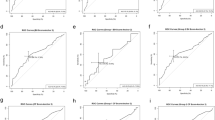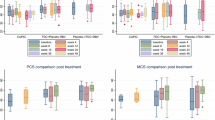Abstract
Purpose
To describe the psychometric properties and identify the minimally important difference (MID) of the hepatitis C virus patient-reported outcomes (HCV-PRO) instrument. Chronic HCV infection and associated treatments negatively affect PROs of function and well-being.
Methods
In a phase 2 trial, HCV-infected patients received direct-acting antivirals (DAAs) for 12 weeks with peg-interferon/ribavirin (peg-IFN/RBV) for 48 weeks, or placebo plus peg-IFN/RBV. The HCV-PRO total score, SF-36 PCS and MCS scores, EQ-5D-3L, and EQ VAS were measured at baseline, week 8, end of DAA treatment (EODT), end of peg-IFN/RBV treatment (EOT), and posttreatment week 24 (SVR24). Convergent validity of the HCV-PRO was assessed by Pearson’s correlation coefficients. Discriminant validity was assessed by analyzing mean HCV-PRO total scores by EQ-5D anxiety/depression and pain/discomfort domain scores (none vs. some) and presence/absence of depression or fatigue adverse events. MID was identified through effect size (ES) and receiver-operating characteristic (ROC) curve analyses (HCV-PRO response vs. SF-36 PCS/MCS and EQ VAS MID thresholds).
Results
In 74 patients (22 % female; 81 % White; 51 % ≥50 years), correlations (0.64–0.96) between HCV-PRO total scores, SF-36 PCS/MCS scores, and EQ VAS scores at all time points supported convergent validity. HCV-PRO total scores were reduced to 10–30 points in patients impaired by depression, pain, or fatigue symptoms. Impact of peg-IFN/RBV regimen on HCV-PRO ES increased over time (EODT −0.76; EOT −0.93). ES and ROC curve analyses indicated an MID of −10 points.
Conclusion
The HCV-PRO was valid and responsive in the population studied. An MID of −10 points represented a threshold of clinical significance for the HCV-PRO.

Similar content being viewed by others
References
World Health Organization. (2012). Hepatitis C. Fact Sheet N°164. Geneva, Switzerland: World Health Organization. Accessed September 17, 2012, from http://www.who.int/mediacentre/factsheets/fs164/en/.
Smith, B. D., Morgan, R. L., Beckett, G. A., Centers for Disease Control and Prevention, et al. (2012). Recommendations for the identification of chronic hepatitis C virus infection among persons born during 1945–1965. MMWR Recomm Rep, 61(RR-4), 1–36.
Davis, G. L., Alter, M. J., El-Serag, H., Poynard, T., & Jennings, L. W. (2010). Aging of hepatitis C virus (HCV)-infected persons in the United States: A multiple cohort model of HCV prevalence and disease progression. Gastroenterology, 138, 513–521.
Ware, J. E, Jr, Bayliss, M. S., Mannocchia, M., & Davis, G. L. (1999). Health-related quality of life in chronic hepatitis C: Impact of disease and treatment response. The interventional therapy group. Hepatology, 30, 550–555.
Younossi, Z., Kallman, J., & Kincaid, J. (2007). The effects of HCV infection and management on health-related quality of life. Hepatology, 45, 806–816.
Hsu, P. C., Federico, C. A., Krajden, M., et al. (2012). Health utilities and psychometric quality of life in patients with early- and late-stage hepatitis C virus infection. Journal of Gastroenterology and Hepatology, 27, 149–157.
DiBonaventura, M. D., Wagner, J. S., Yuan, Y., L’Italien, G., Langley, P., & Ray Kim, W. (2010). Humanistic and economic impacts of hepatitis C infection in the United States. Journal of Medical Economics, 13, 709–718.
Ghany, M. G., Strader, D. B., Thomas, D. L., & Seeff, L. B. (2009). Diagnosis, management, and treatment of hepatitis C: An update. Hepatology, 49, 1335–1374.
Thein, H. H., Krahn, M., Kaldor, J. M., & Dore, G. J. (2005). Estimation of utilities for chronic hepatitis C from SF-36 scores. American Journal of Gastroenterology, 100, 643–651.
Bergmann, J. F., Vrolijk, J. M., van der Schaar, P., et al. (2007). Gamma-glutamyltransferase and rapid virological response as predictors of successful treatment with experimental or standard peginterferon-alpha-2b in chronic hepatitis C non-responders. Liver International, 27, 1217–1225.
Hassanein, T., Cooksley, G., Sulkowski, M., et al. (2004). The impact of peginterferon alfa-2a plus RBV combination therapy on health-related quality of life in chronic hepatitis C. Journal of Hepatology, 40, 675–681.
Bernstein, D., Kleinman, L., Barker, C., Revicki, D. A., & Green, J. (2002). Relationship of health-related quality of life to treatment adherence and sustained response in chronic hepatitis C patients. Hepatology, 35, 704–708.
Younossi, Z. M., Aggarwal, J., Martin, M., et al. (2012). Health-related quality-of-life among genotype 1 treatment-naïve chronic hepatitis C patients receiving telaprevir combination treatment: Post-hoc analyses of data from the ADVANCE trial. Journal of Hepatology, 56(Suppl 2), S462–S463.
Younossi, Z. M., Aggarwal, J., Martin, M., et al. (2012). Health-related quality-of-life among genotype 1 treatment-naïve chronic hepatitis C patients receiving telaprevir combination treatment: Post-hoc analyses of data from the ADVANCE trial. Gastroenterology, 142(Suppl 5), S-955. [Abstract Sa1048].
Gralnek, I. M., Hays, R. D., Kilbourne, A., et al. (2000). Development and evaluation of the liver disease quality of life instrument in persons with advanced, chronic liver disease–the LDQOL 1.0. American Journal of Gastroenterology, 95, 3552–3565.
Bayliss, M. S., Gandek, B., Bungay, K. M., Sugano, D., Hsu, M. A., & Ware, J. E, Jr. (1998). A questionnaire to assess the generic and disease-specific health outcomes of patients with chronic hepatitis C. Quality of Life Research, 7, 39–55.
Anderson R. T., Baran R. W., Dietz B., Kallwitz E., Erickson P., Revicki D. A. (2013). Development and psychometric evaluation of the hepatitis C virus-patient reported outcomes (HCV-PRO) instrument. Qual Life Res, in review.
Food and Drug Administration. (2009). Guidance for industry on patient-reported outcome measures: Use in medical product development to support labeling claims. Federal Register, 74, 65132–65133.
Revicki, D. A., Hays, R., Cella, D., & Sloan, J. (2008). Recommended methods for determining responsiveness and minimally important differences for patient-reported outcomes. Journal of Clinical Epidemiology, 61, 102–109.
Gaultier, I., Cohen, D. E., Bhathena, A., et al. (2011). The effect of IL28B polymorphism on virologic response to treatment with pegylated interferon alpha-2a and RBV (SOC) added to ABT-450/ritonavir (ABT-450/r), ABT-333, or ABT-072. Journal of Hepatology, 54(Suppl 1), S523.
Ware, J. E, Jr, Kosinski, M., Bjorner, J. B., Turner-Bowker, D. M., Gandek, B., & Maruish, M. E. (2007). User’s manual for the SF-36v2 health survey (2nd ed.). Lincoln, RI: QualityMetric Incorporated.
The EuroQol Group. (1990). EuroQol–a new facility for the measurement of health-related quality of life. Health Policy, 16, 199–208.
Nunnally, J. C., & Bernstein, I. H. (1994). Psychometric theory (3rd ed.). New York, NY: McGraw-Hill Inc.
Strand, V., Boers, M., Idzerda, L., et al. (2011). It’s good to feel better but it’s better to feel good and even better to feel good as soon as possible for as long as possible. Response criteria and the importance of change at OMERACT 10. Journal of Rheumatology, 38, 1720–1727.
Spiegel, B. M. R., Younossi, Z. M., Hays, R. D., Revicki, D., Robbins, S., & Kanwal, F. (2005). Impact of hepatitis C on health related quality of life: A systematic review and quantitative assessment. Hepatology, 41, 790–800.
Coteur, G., Feagan, B., Kleininger, D. L., & Kosinski, M. (2009). Evaluation of the meaningfulness of health related quality of life improvements as assessed by the SF-36 and EQ-5D VAS in patients with active Crohn’s disease. Alimentary Pharmacology and Therapeutics, 29, 1032–1041.
Acknowledgments
The authors thank Martin S. King, PhD, Lois Larsen, PhD, and Wangang Xie, PhD (Department of Statistics, AbbVie, Abbott Park, Illinois) for substantial analytical contributions to the development and validation of the HCV-PRO instrument, and Dana L. Randall, MS, PharmD (Arbor Communications, Inc., Ann Arbor, Michigan) for medical writing support. Mudra Kapoor, MD (AbbVie), is also acknowledged for her medical review of content. The clinical study (M11-602) and the HCV-PRO psychometric analyses were funded in full by AbbVie. Data analyses were completed by Martin S. King, PhD, Lois Larsen, PhD, and Wangang Xie, PhD, who are employees of and received funding from AbbVie. Writing support was provided by Dana L. Randall, MS, PharmD, of Arbor Communications, Inc., Ann Arbor, Michigan, and funded by AbbVie.
Conflict of interests
Robert W Baran and Katherine Gooch are employees of and may own stocks and shares in AbbVie. Birgitta Dietz is an employee of and owns stocks and shares of Abbott GmbH & Co. Dennis A. Revicki has served as a consultant and an advisory board member for AbbVie and has received research funding from AbbVie. Roger T. Anderson and Pennifer Erickson have served as consultants and as advisory board members for AbbVie.
Author information
Authors and Affiliations
Corresponding author
Rights and permissions
About this article
Cite this article
Anderson, R.T., Baran, R.W., Erickson, P. et al. Psychometric evaluation of the hepatitis C virus patient-reported outcomes (HCV-PRO) instrument: validity, responsiveness, and identification of the minimally important difference in a phase 2 clinical trial. Qual Life Res 23, 877–886 (2014). https://doi.org/10.1007/s11136-013-0519-1
Accepted:
Published:
Issue Date:
DOI: https://doi.org/10.1007/s11136-013-0519-1




